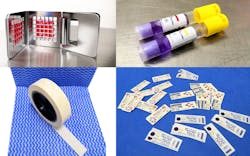All key indicators point to change
2021 has been a significant year in the field of Central Service/Sterile Processing & Distribution (CS/SPD), with several guidance changes impacting the processing of instruments and devices, and changes in terminology and language that redefine the CS/SPD profession.
The International Association of Healthcare Central Service Materiel Management (IAHCSMM) Board of Directors voted to change the name of the organization to the “Healthcare Sterile Processing Association (HSPA),” effective January 1, 2022, which the the board states “better reflects the role of the professionals we represent.”1
Also in 2021, The Joint Commission issued New Water Management Requirements, requiring hospitals to have a water management program that addresses Legionella and other waterborne pathogens.2 With the effectiveness of CS/SPD operations reliant on the quality of water and steam used in the decontamination, cleaning and sterilization processes, this change is likely to impact hospital CS/SPD departments.
Perhaps one of the most impactful changes to sterile processing workflow this year is the Association for Advancement of Medical Instrumentation’s (AAMI) amendments to ANSI/AAMI ST79 Comprehensive guide to steam sterilization and sterility assurance in health care facilities, “offering users new clarity and fresh guidance to stay in compliance with accrediting bodies.”3 Amendment 3 and 4 change recommendations on the frequency of sterilizer cleaning and the put into place requirements for the recording of biological indicator (BI) lot numbers in sterilizer records.
In light of these and other changes impacting the field, industry experts offer their insights on the current state of sterility and quality assurance in the CS/SPD department, including advice on how to improve compliance with industry guidelines and manufacturer’ instructions for use (IFU).
Decontaminate, test, disinfect
“If you go into an SPD and the team isn’t following the rules and regulations, I guarantee the rest of the hospital isn’t either,” commented Greene-Golden. “I remind my team members that if they were the patient in the operating room (OR), they would want everything cleaned to the highest standards; therefore, they should work to ensure they do that for everyone.”
Given the critical importance of cleaning and disinfection to instrument quality and safety, some CS/SPD leaders took the time to evaluate their processes and make improvements aligned to industry standards during COVID-driven surgical case slowdowns. They are reaping the benefits today as case volumes grow closer to pre-pandemic levels.
“Healthcare organizations must clean and disinfect to maximize patient safety and to reduce the risk of transmission of antibiotic-resistant pathogens,” commented Christine Hilbert, Ph.D., MBA, Marketing Technical Writer, Hygiena. “Recently, the COVID-19 pandemic has raised public awareness of the need to control the spread of infectious diseases, making it even more important that healthcare professionals monitor the effectiveness of both cleaning and disinfection/sterilization procedures.”
The CS/SPD team at NorthShore University HealthSystem based out of Evanstan, Ill. was one of these proactive organizations, designing standard decontamination workflows and cleaning pathways based on ANSI/AAMI ST79 and the Association of periOperative Registered Nurses (AORN) Guideline for care and cleaning of surgical instruments. The leaders of the initiative, Courtney Mace Davis, MBA, CMQ/OE, CHL, CRCST and Joan M. Spear, MBA, RN, CNOR, CRCST, published a summary of their work in the August 2021 AORN Journal.
To confirm that the proposed standard decontamination workflows and cleaning pathways were effective, the CS/SPD team performed cleanliness verification tests on sets that contained complex instruments, including a laparoscopic gynecology set and a sinoscopy set following extended time between point of use (POU) and decontamination steps. After set decontamination in compliance with the proposed standardized workflow, the sterile processing manager performed cleanliness testing on instruments from each of the test instrument sets. Of the nine instruments tested, all passed the test. Periodic cleanliness testing followed implementation of the new workflows as a part of the Quality Systems in place.4
Mace Davis comments on their work, stating:
“Most of us in sterile processing departments understand the importance of following instrument IFUs in decontamination. However, this can be challenging to do and the IFU review must be based on each department’s own medical devices/instruments, equipment, cleaning agents, and POU process. Additionally, the workflow expectations of frontline SPD staff can be varied and complex. As leaders our job is to make steps easy to follow so our technicians can follow the processes each and every time. Using data obtained from cleaning verification tests, such as borescope inspection and residual protein detection, give us confidence we are following our processes and that the devices/instruments are clean.”
Two separate but vital tasks
As Hilbert explains, cleaning and disinfection are two separate tasks, and it is during the cleaning process that CS/SPD team members must do the hard work of removing organic material (aka bioburden) from surfaces. She states:
“Disinfectants are not designed to remove organic material, whether bacterial, viral or other debris. Instead, disinfectants are made to ensure that clean surfaces stay microbe-free. Disinfectant application needs to follow a good cleaning of the surfaces with enough force to thoroughly remove most of the unwanted material. Even after cleaning, surfaces can have gaps that might harbor potential pathogens. Therefore, it is critical to not only clean but also to disinfect and test areas to confirm they are free of contaminants.”
Hilbert says visual inspection is not enough to determine if a surface is clean and microbial tests (swabbing surfaces and then testing for growth in a lab) take days for results. She comments on how facilities have increasingly turned to new technologies that can quickly provide objective and reliable measurements of cleanliness.
“A rapid, reliable, easy-to-use solution is adenosine triphosphate monitoring (ATP testing),” explained Hilbert. “ATP is an indicator of biological residue, including bacteria, yeast and mold, so it is an excellent measure of cleanliness. In addition, ATP testing provides results in seconds and is sensitive, quantitative, effective and straightforward. General protein tests (i.e., Pro-Clean) can also be usefully in making sure residual proteins have been removed.”
Sterilization best practices
The world of CS/SPD is not static, rather as instruments and IFUs change, and industry associations and regulatory bodies change their stance on practices, sterile processing teams must adapt to remain effective, safe and compliant. And as practices evolve, CS/SPD departments can benefit from validity testing at each step of their process.
“These audits should include proper placement of chemical indicators, tray weight evenly distributed, using correct wrapper size and strength or correct rigid container, and choosing the correct sterilization cycle,” explained Tull.
Sterilizer operation
“An overfull sterilizer cart reduces steam penetration and circulation,” he commented. “When sets are not appropriately orientated on the cart, it can impede steam but may also trap water and create wet loads. Guidance on properly loading of sterilizers can be found in the sterilizer and packaging IFUs and in guidance documents like ANSI/AAMI ST79.”
“Trays should be loaded flat on the sterilizer cart and not placed on their sides unless they are non-perforated (e.g., basins and mayo trays),” Malinda Elammari, ST, CSPM, CSPDT, CFER, CSIS, CRCST, CIS, CHL, CER, CLSSGB, Clinical Education Specialist, Healthmark Industries added. “Keeping trays flat ensures the metal mass stays evenly distributed. Additionally, rigid trays should never be stacked unless validated by the container IFU. Heavier trays are always positioned below lighter trays and wrapped trays above rigid containers in mixed loads. Peel pouches are placed on the top shelf, standing on their edge, facing in the same direction.”
Sterilizer cleaning
One of the 2021 amendments to ANSI/AAMI ST79 has a direct impact on sterilizer cleaning practices. Amendments 3 eliminates previously stated recommendations on daily cleaning of sterilizers, instead urging CS/SPD teams to follow the sterilizer manufacturer’s IFU when cleaning this equipment.
Hendee commended on these amendments during an episode of the company’s Ask the Educator podcast, stating:
“Instead of AAMI taking a stance that might have been contradictory to an IFU, they said we are going to pull that back and say your IFU should tell you what to look for and if abnormalities are found (e.g., staining, debris), also follow your IFU. That will most likely prescribe cleaning but again; that is up to the sterilizer manufacturer. It is their product and they should give us the guidance.”
Testing and monitoring
There are a variety of tests that CS/SPD team can employ to assess sterility assurance. Biological indicators (BI) contain microorganisms to test the effectiveness of steam, hydrogen peroxide gas, ethylene oxide and other sterilization methods.
Common chemical indicators employed include Type 1 chemical indicators to help differentiate between processed and unprocessed loads, Type 2 chemical indicators, such as Bowie-Dick tests, to monitor steam sterilizers for air removal efficiency and steam penetration, and Type 5 chemical indicators to test the parameters of time, temperature and steam.
Amendment 4 of the ANSI/AAMI ST79 guidelines is around the recording of BI lot numbers. As Hendee explained in the recent podcast episode, CS/SPD teams must now not only record the BI that was run, but also the BI control lot number as well.
“For those CS/SPD departments with electronic systems that already attach their control results and lot number to each load, it should be very easy to comply,” said Hendee. “But those with manual systems where things are written down, they will have to figure out a system to make it work.”
With regards to Bowie-Dick tests used for routine monitoring of sterilizer air leaks and inadequate air removal, and Type 5 chemical indicators to test time, temperature and pressure, it is important to follow instructions to ensure the tests are correctly performed, explains John Sullivan, Director, Crosstex International, part of the Hu-Friedy Group a Steris Company.
“There have been more than a few times that a facility will call us and say our Bowie Dick or Type 5 tests are not working. After further research and investigation at the facility we find that our products are working and doing exactly what they are designed to do and that is identify issues. Facilities want to make sure that the product they are using are performing, they also want to be able to see a Type 5 in the container when they open it and that they are priced fairly.”
Selecting an indicator
When evaluating potential indicator technology, Dr. Garrett recommends CS/SPD professionals ensure the indicator product has the necessary regulatory body approvals (e.g., FDA), meets the intended use of the product within the clinical setting, and has extensive clinical testing data to demonstrate its efficacy.
“Finally, the indicator should be cost effective and easy to implement within one’s health system,” Dr. Garrett added.
With regards to ease of use, the U.S. Food and Drug Administration (FDA) has raised the issue of CS/SPD team members misinterpreting indicator results because there is no standard indicator color to indicate a sterilized device. The agency has urged departments to “enhance staff training on the indicators for all sterilization systems employed in the facility.”5
“Each manufacturer has developed its own color scheme to validate the sterilization process, and the colors vary among manufacturers even though many are validated for the same cycle conditions,” explained Zarembinski. “The FDA is collaborating with manufacturers of sterilization systems to improve product labeling and explore standardization for colors used to indicate sterilization. It’s important to always address the sterilization indicator’s IFU on how to interpret the indicator results.”
Hendee stresses the importance of indicator compatibility, noting how many indicators on the market are not designed for extended cycles, which are becoming more common in the CS/SPD. He states:
“These cycles may be appropriate per the instrument IFU but are they appropriate per the indicator IFU? Most type 5 chemical indicators and biological indicators are designed to monitor a four-minute sterilization cycle. Because of this, you need to ask yourself, are they appropriate for a longer sterilization time? For example, type 5 indicators react to all critical variables within a cycle. When the critical variable of time changes, shouldn’t the type 5 indicator change as well.”
Education and training
As with most aspects of sterile processing, sterility and quality assurance goes back to effective staff education and training. Key Surgical Clinical Educator Michelle Lemmons comments on this point, stressing how important it is for CS/SPD staff members to be able to confidently and independently evaluate effectiveness and have a working knowledge of how to troubleshoot issues that they encounter.
“It is critical to educate staff on how the equipment works, new products, who to contact if they have questions and WHY each step is needed,” said Lemmons. “Also, providing opportunities for education and certification advances the sterile processing profession, allows for personal and professional growth of the individual, and increases the visibility of sterile processing’s incredible value to the facility.”
“Best practices for ensuring effective sterilization include a well-trained staff, documenting your processes to verify the requirements are being performed for the task at hand, and auditing your process to see if there are any areas of improvement,” Zarembinski added. “Most standards and industry guidelines lay out the baseline expectation for best practices, implementing these into a facility policy along with specific requirements established by the healthcare facility will maximize effective sterilization.”
Elammari says she has seen two positive impacts on CS/SPD quality assurance recently: the addition of educators and the implementation of huddle boards at shift huddles, stating:
“The addition of educators specific to SPD has positively impacted the facilities that have implemented this role. They provide staff with resources for additional education and professional growth. Another impact is the use of huddle boards during shift huddles. When used correctly, they help close communication gaps, allow staff to speak up and encourage them to take ownership for issues they bring forth. It also allows for discussion concerning essential factors they will face for the day.”
Tull points to increased requests from surgeons for vendor trays as a challenge to CS/SPD staff competency, noting how greater in-servicing and training can help boost quality when processing these items.
“With the increased use in vendor trays, there is an increased need to have a strong QA process in sterile processing,” Tull commented. “There are so many different companies and systems that staff must be in-serviced so that when performing QA checks knowledge of critical instruments are a must.”
Looking to the future
Looking to the future of CS/SPD, Hendee sees a trend towards centralized instrument processing. He acknowledges that while this is not a new concept, it is being utilized in more situations than ever before.
“SPDs have been processing (cleaning and sterilizing) instruments for clinics and nursing floors within the facility for decades, but now processing departments are being asked to push this service well beyond those walls,” said Hendee. “While this may help in standardizing processes across the organization, it adds challenges as well. Ensuring quality in a centralized structure will require careful planning, especially around the external transport of these instruments.”
Dr. Garrett has seen an increased interest in system-wide sterilization and sterile processing, referencing continued focus by the FDA and infection prevention departments on the CS/SPD. In his opinion, greater adoption of automation and monitoring technologies is key to overcoming current challenges in quality and safety. He states:
“Given the high rate of personnel turnover and the growing complexity of reprocessing and sterilization processes for each device, there is a high potential for human error that exists in the equation. This can lead to cross-contamination of surgical instruments and subsequent potential infection risks to the patient. Innovative automation and monitoring technologies are rapidly entering the medical market and show tremendous promise in optimizing clinical workflow, but also in reducing infection risks to patients when all steps in the reprocessing or sterilization process for a device are properly and consistently adhered to.”





